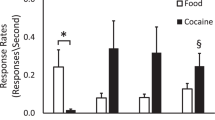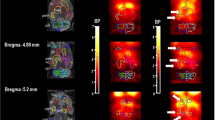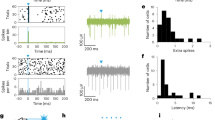Abstract
Despite considerable knowledge about brain dopamine in drug-induced and pathological states, the dynamic relationship of dopamine to voluntary motor behaviour is not established. In an effort to produce selective, lateralized changes in brain dopamine metabolism associated with movement, we have now developed an animal model in which normal rats were trained to circle for a sucrose/water reward. Turning direction was randomly assigned. The effect of circling on dopamine metabolism was studied by killing animals during the reinforcement period and measuring caudate dopamine and dihydroxyphenylacetic acid (DOPAC) concentrations in both sides of brain. Prior to turning, caudate dopamine and DOPAC levels were the same bilaterally. By contrast, animals killed after 20 min of circling showed a 67% increase in dopamine and a 46% increase in DOPAC concentrations in the caudate contralateral to the turning direction while the ipsilateral caudate showed no concentration changes. Such a rapid, massive unilateral increase in caudate dopamine metabolism suggests that dopamine neurones in contralateral caudate are selectively activated during circling behaviour. This model should be useful for further study of the relationships between neurotransmitter activity, regional brain physiology and voluntary movement, without the need for drugs or brain lesions.
This is a preview of subscription content, access via your institution
Access options
Subscribe to this journal
Receive 51 print issues and online access
$199.00 per year
only $3.90 per issue
Buy this article
- Purchase on Springer Link
- Instant access to full article PDF
Prices may be subject to local taxes which are calculated during checkout
Similar content being viewed by others
References
Pycock, C. J. Neuroscience 5, 461–514 (1980).
Ungerstedt, U. Acta physiol. scand. Suppl. 367, 69–93 (1971).
Glick, S. D., Jerussi, T. P. & Zimmerberg, B. in Lateralization in the Nervous System (ed. Harnad, S.) 213–249 (Academic, New York, 1977).
Jerussi, T. P. & Glick, S. D. Psychopharmacology 47, 249–260 (1976).
Freed, C. R. & Asmus, P. A. J. Neurochem. 32, 163–168 (1979).
Javoy, F. & Glowinski, J. J. Neurochem. 18, 1305–1311 (1971).
Yamamoto, B. K., Lane, R. F. & Freed, C. R. Life Sci. 30, 2155–2162 (1982).
Nagatsu, T., Levitt, M. & Udenfriend, S. Analyt. Biochem. 9, 122–126 (1964).
Nieoullon, A., Cheramy, A. & Glowinski, J. Nature 266, 375 (1977).
Author information
Authors and Affiliations
Rights and permissions
About this article
Cite this article
Yamamoto, B., Freed, C. The trained circling rat: a model for inducing unilateral caudate dopamine metabolism. Nature 298, 467–468 (1982). https://doi.org/10.1038/298467a0
Received:
Accepted:
Published:
Issue Date:
DOI: https://doi.org/10.1038/298467a0
This article is cited by
Comments
By submitting a comment you agree to abide by our Terms and Community Guidelines. If you find something abusive or that does not comply with our terms or guidelines please flag it as inappropriate.



